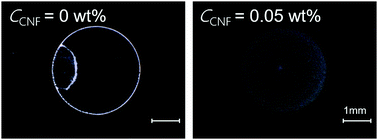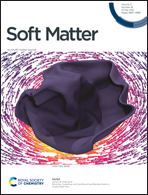Spatio-temporally controlled suppression of the coffee-ring phenomenon by cellulose nanofibers
Abstract
Sessile droplets of colloidal dispersions tend to exhibit the coffee-ring phenomenon in the drying process. The suspended particles are transported especially at the final stage of the drying process, which is called the rush hour. Conventional inkjet printers require the ink liquid to have a sufficiently low viscosity for inkjet discharge, but such liquids tend to be subject to the coffee-ring effect. The coffee-ring effect is an issue for conventional printing applications and drawing wires in printed electronics. We show by microscopy movie data analysis based on single particle tracking that the addition of a small amount of cellulose nanofibers (CNFs) to the colloidal dispersion works in such a way that the initial low concentration satisfies the low viscosity requirement, and the three-dimensional structural order of the CNFs formed during the final stage of droplet drying owing to the high concentration hinders the transport of particles to the periphery, suppressing the coffee-ring effect. This is a spatio-temporally controlled process that makes use of the inherent process of ordinary ink printing situations by the simple protocol. This is also an approach to seamlessly link the ink and substrate since CNFs are regarded as a promising substrate material for flexible devices in printed electronics because of their fine texture that keeps conductive nanoparticles on the surface.



 Please wait while we load your content...
Please wait while we load your content...